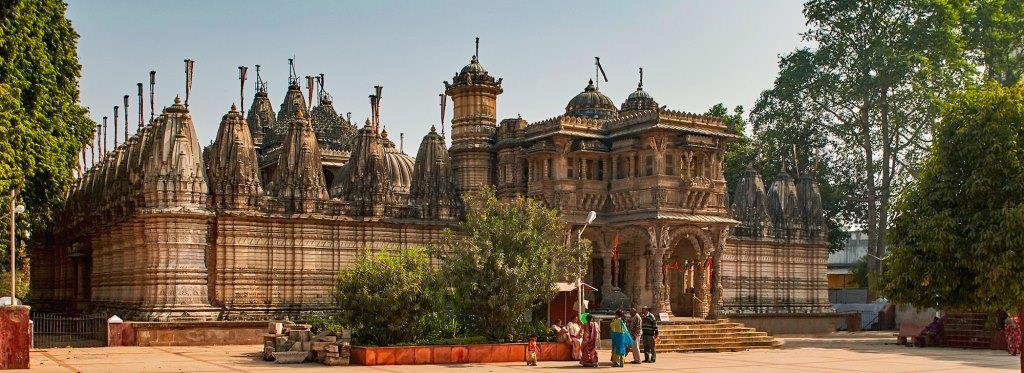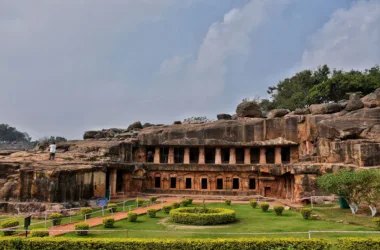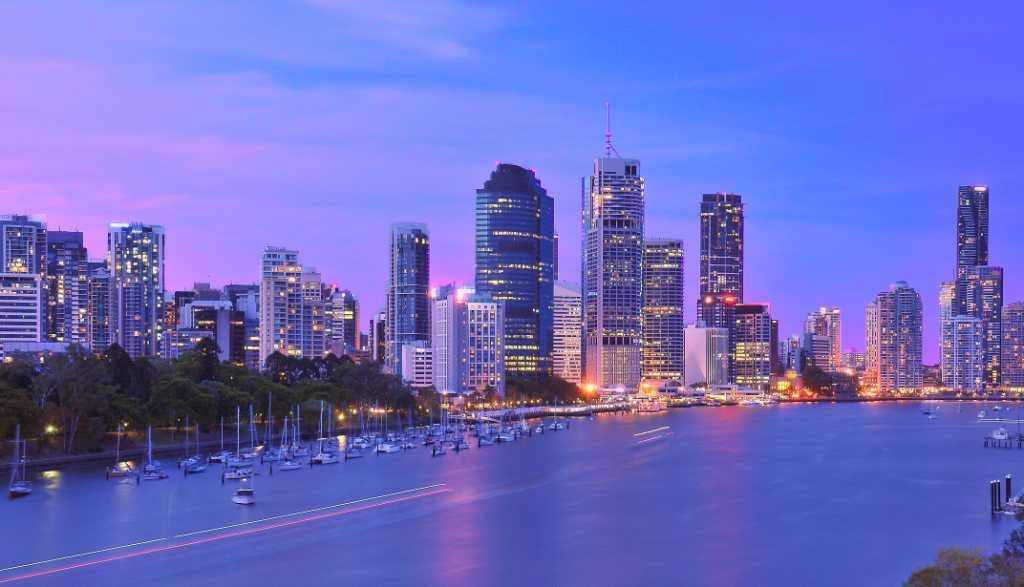The city of Ahmedabad is endowed with a rich architectural heritage which is important for the local identity and continuity of the place. With major heritage Indo-Islamic monuments dating from the 15th to 17th centuries, there are potential heritage complexes in the form of Poles, a traditional residential cluster of medieval times, that makes Ahmedabad exceptional. All this combined, the historic walled city of Ahmedabad is the first city in India to be inscribed on UNESCO’s 2017 World Heritage City list.
Historic City of Ahmedabad: Situated in the heart of Gujarat, Ahmedabad has a character like no other, defined by the spirit of enterprise. Although Ahmedabad is a bustling metropolis with prestigious institutions and a rapidly growing economy, it is also deeply rooted in tradition. The city is known for its association with Mahatma Gandhi and hosts some of the best medieval Islamic architecture in the country, in addition to a complex maze of neighborhoods called pols.
The city of Ahmedabad was formerly known as Asha Bhil’s Ashal; Karnavati of Karnadev, Ahmedabad of Sultan Ahmed Shah, Rajnagar the capital of Jainism, the politico-cultural city of Mahatma Gandhi and Sardar Patel of Amdavadis and Amdavad. The British wrote it as Ahmedabad and it came to be known internationally as Ahmedabad. But in the local language, it became popular as Amdavad and all Gujaratis know it as Amdavadi. Citizens are known around the world as Amdavadis.
There are hundreds of temples, mosques and other pilgrimage sites in the city. Amidst all this, one place that attracts our attention is none other than the Sabarmati Ashram, which was presented to the nation by Gandhiji, his humble abode known as Hridaykunj.
Ahmedabad | Attraction
Shree Swaminarayan Mandir Kalupur
About the Location: The splendid, multicolored, wood-carved Swaminarayan Mandir in the old city, was built in 1822 as the first temple of the Swaminarayan Hindu sect. Followers believe that Swaminarayan (1781–1830), the founder of the sect, was the supreme being. The daily heritage walk here usually begins at 8 a.m. with a puja at the temple, which is thronged by devotees. Each paneling is made of Burma teak wood with artistic ornamentation. The entrance gate sculptures also have Rajasthani costumes and colours. The main deities of the temple are Nar Narayan Dev, Shri Radha Krishna Dev, Shri Dharmabhaktimata and Hari Krishna Maharaj, Shri Bal Swaroop Ghanshyam Maharaj and Shri Rangmohal Ghanshyam Maharaj. The western part of the temple has been allotted as the abode of ascetic or Samkhya yogi women.
Brief History: The origin of the temple dates back to the early 19th century when most parts of India were dominated by the British. It is the first temple of the Swaminarayan sect, and was built on the instructions of the founder Shree Swaminarayan Bhagwan. One officer was so impressed by Sir Dunlop Swaminarayan’s activities that he donated 5,000 acres of land on behalf of the government for the establishment of the temple. Once the impressive structure was built, he conducted a 101 gun salute to the temple. Various sections of the temple were added later. The main structure was divided into the North Gateway, Nar Narayan Mandir, Akshar Bhawan, Rang Mahal and the residences of the pious women and students. A haveli built by Acharya Maharajshri Keshavprasadji Maharaj was built in 1871.
Hutheesing Jain Temple
About the place: This remarkably beautiful temple made of white marble has been sacred to many Jain families from generation to generation. It was built in 1848 AD at an estimated cost of 10 lakh rupees by a wealthy merchant Sheth Hutheesing as a dedication to the 15th Jain Tirthankara, Shri Dharmanath. The traditional stone artisans belonged to the Sonpura and Salat communities. The Salat community built architectural masterpieces ranging from forts, palaces to temples. The credit for the work of Hutheesing Jain Temple goes to Premchand Salat. One scholar has remarked, “As we move towards the sanctuary, so does the dignity of each part. Whether viewed from its court or from outside, there is diversity without confusion and the importance of each part.” suitability for the purpose for which it was intended.”
Located outside the Delhi Gate, the temple is spread over a vast courtyard, a mandapa surrounded by a large roofed dome, supported by 12 ornate pillars. The small sanctum (main shrine) at the eastern end reaches three wonderfully carved minarets and is surrounded by 52 smaller shrines dedicated to various Tirthankaras. On the three outer sides there are large raised porches with lavishly decorated pillars and figural brackets. In addition, the recently constructed 78 feet Mahavir Stambha (tower) after the famous tower at Chittor, Rajasthan faces the outer courtyard from the front entrance. Some of the motifs used in the design are reminiscent of the minarets of the Sultanate of the Mughal period.
Jama (Jumma) Masjid
About the Location: Built by Ahmed Shah in 1423, the Jama Masjid (Friday Mosque) on Mahatma Gandhi (MG) Road is one of the most beautiful mosques in India, enhanced by a vast, peaceful courtyard. The mosque displays some architectural fusion with Hinduism and Jainism, notably in the lotus-like carvings of some of the domes, similar to many Jain temples. The 260 columns of the prayer hall support 15 major domes at different heights. There were once two ‘shaking’ minarets, but they lost half their height in the great earthquake of 1819, although their lower parts still edge the central portico of the prayer hall.
Brief History: Jama Masjid, the principal place of prayer for Muslims was built in the 15th century during the reign of Ahmed Shah. It is believed to be the largest mosque in the Indian subcontinent. The mosque was constructed as part of a larger design of the city. It is located to the south of the axis of the procession that runs from Maidan-e Shah in the old city with three arches called the three doors. Ahmed Shah, his son and grandson have mausoleums to the west of the mosque. A short walk away is Rani no Hajir, the tombs of the dynasty’s queens and wives.
Calico Museum of Textiles
About Location: This museum houses the world’s finest collection of ancient and modern Indian textiles, all handmade and as old as 500 years. There are some amazingly beautiful pieces, showcasing incredible virtue and extravagance. You’ll see cashmere shawls that took three years to make, and double-ikat fabrics whose 100,000 threads were each individually dyed before weaving. The main textile galleries can only be visited in the morning session. Tours last two hours with a maximum of 25 people – 15 by group booking and 10 on a first-come-first-served basis. Arrive by 10 a.m. to maximize your chances of getting in. The afternoon tour (maximum 15 people, all first-come-first-served) is dedicated to the Sarabhai Foundation’s collection of religious art, exploring depictions of Indian gods, and a textile gallery.
Brief History: The Calico Museum was founded in 1949 by industrialist Gautam Sarabhai and his sister Gira Sarabhai, and was inaugurated by Prime Minister Jawaharlal Nehru. Ahmedabad has always had a thriving textile industry which was at its peak in the late 1940s. It was inspired by the philosopher, metaphysician and leading historian and philosopher of Indian art, Ananda Kumaraswamy. Kumaraswamy sowed the seeds in the mind of Shri Gautam Sarabhai and suggested that the museum should be placed in Ahmedabad, as it was a major textile centre. After several negotiations and researches, Shri Sarabhai, his sister Jira Sarabhai and the industrial house of Calico created this specialist museum based on historical and technical studies of Indian handicrafts and industrial textiles.
It was originally housed in Calico Mills, but as the collection grew, it was shifted to Sarabhai House in Shahibagh in 1983. In the 1960s, the museum began a publication program around the historical textiles of India under the edification of John Irwin. Keeper of the Indian Section of the Victoria and Albert Museum, and another, under the editorial direction of Dr Alfred Bühler, who conducted a Contemporary Textile Crafts Survey of India.
Siddi Sayed Mosque
About Location: The Sidi Sayyed Mosque is famous for its exquisite lattice windows, cobwebs depicting the intricately intertwined branches of the ‘tree of life’ which are best viewed from the road leading behind the mosque . The central arch of the mosque is also devoid of intricate latticework, leading the eyes directly to the main stunning work on the back wall. The mosque still serves as a place of prayer.
Brief History: Popularly known as Sidi Sayyed ni Jali, this mosque was built by Sidi Sayyed in the period 1572-73 AD. This was the same year that the Mughals conquered Gujarat. Sayyid was an Abyssinian saint of African descent who served in the army of Ahmad Shah. They belonged to a community different in culture and appearance that still live in parts of Gujarat today.
Bhadra Fort
About Location: Climb the Bhadra Fort and have a bird’s eye view of the old city. Built soon after the founding of Ahmedabad in 1411, the Bhadra Fort now houses government offices and a Kali temple. Its gates formed the eastern entrance to the Ahmedabad citadel, which extended to the river in the west. From the terrace you can have views of the grand structure and the surrounding streets. Between the fort and the Teen Darwaza (Triple Gateway) to its east was the ground Shahi (Royal Square), where royal processions and polo games were held.
Brief History: Bhadra Fort was built by the founder of the city, Ahmad Shah in 1411 AD. The name of the fort is derived from the Bhadrakali temple located nearby. Centuries ago the fort was also called Arch Fort. The British captured the fort in 1817 and used it as a prison until independence. It was duly renovated in 2014 so that people can get a glimpse of the history.
Read about more heritage site
Frequently Asked Questions About Ahmedabad a heritage city
Q. Why is Ahmedabad a heritage city?
A – The city of Ahmedabad is endowed with a rich architectural heritage which is important for the local identity and continuity of the place. All this combined, the historic walled city of Ahmedabad is the first city in India to be inscribed on UNESCO’s 2017 World Heritage City list.
Q. How many heritage sites are there in Ahmedabad?
A – Ahmedabad includes 28 monuments listed by the Archaeological Survey of India (ASI), one monument listed by the State Archaeological Department (SDA) and 2,696 important buildings protected by the Heritage Department in the Ahmedabad Municipal Corporation (AMC).
Q. How old is the city of Ahmedabad?
A – The city was founded in 1411 as the capital of the Gujarat Sultanate, named after Sultan Ahmed Shah.
Q. What is the old name of Ahmedabad?
A – Some historians say that the area around Ahmedabad has been inhabited since the 11th century, when it was known as Ashaval. The Chalukya ruler Karna of Anhilwara (Patan) defeated King Bhil of Ashaval and founded a city called Karnavati on the banks of the Sabarmati.
Q. What Ahmedabad is famous for?
A – Famous Sites and Landmarks of Ahmedabad
- Textile City
- Law Garden.
- Kankaria Lake
- Kite Museum.
- Lal Darwaja Market.
Q. Which is the oldest building in Ahmedabad?
A – Teen Darwaza, Ahmedabad. The structure was built by Ahmad Shah in 1415, and has three arches; hence the name.















